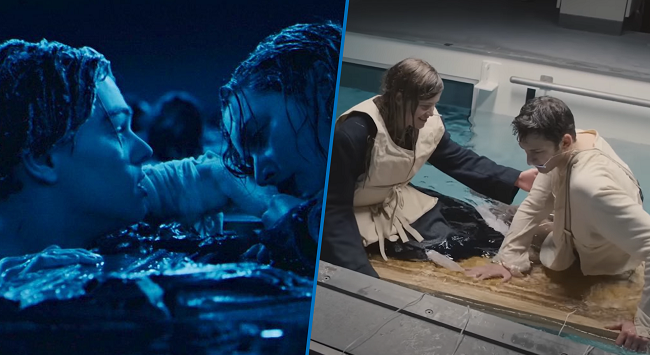
The Unsinkable Debate: James Cameron Recreates the Titanic Door Scene
Few cinematic moments are as universally recognized, passionately debated, and persistently memed as the climax of James Cameron’s Titanic. As the grand vessel slips into its icy tomb, Jack Dawson, the spirited artist, makes the ultimate sacrifice, slipping beneath the waves while his beloved Rose DeWitt Bukater floats to safety on a splintered piece of doorframe. For decades, the internet has buzzed with a singular, indignant question: “Couldn’t Jack have fit on that door, too?” This enduring query, a blend of fan grief and engineering skepticism, finally found its answer when the maestro himself, James Cameron, decided to put the infamous prop to the ultimate scientific test. His recreation of the scene wasn't just a director's playful indulgence; it was a fascinating exploration of artistic ownership, the enduring power of a cinematic myth, and the curious human need to dissect even the most sacred fictional tragedies.
The Titanic door, or more accurately, the carved wooden panel from the ship’s first-class lounge, has transcended its role as a mere prop to become a cultural lodestar. It symbolizes sacrifice, survival, and the heartbreaking "what if" that haunts countless viewers. For years, Cameron, known for his meticulous attention to detail and his uncompromising artistic vision, had largely shrugged off the door debate. Jack had to die; it was a narrative necessity, the very essence of the tragedy. Yet, the question persisted, fueled by countless memes depicting a generous expanse of wood seemingly capable of accommodating two lovers. Perhaps it was the advent of the film’s 25th anniversary, or perhaps simply a director’s unique obsession with the minutiae of his own fictional universe, but Cameron finally decided to address the white whale of fan theories head-on.
The recreation was not a casual dip in a backyard pool. True to Cameron’s reputation, it was a forensic, almost clinical, examination of the scenario. He enlisted hypothermia experts, stunt doubles resembling Leonardo DiCaprio and Kate Winslet in build, and a precise replica of the prop. The experiment began methodically, testing various scenarios: Rose on the door, Jack in the water holding on, both attempting to get onto the debris. The crucial factor, often overlooked in the armchair analyses, was buoyancy and the devastating effects of hypothermia. It wasn't just about whether the wood could support two people, but whether it could keep enough of them out of the water to prevent fatal cold shock and the relentless onset of hypothermia.
The results, as unveiled in the National Geographic documentary "Titanic: 25 Years Later With James Cameron," were nuanced, yet ultimately grim for Jack's hypothetical survival. Initially, with both actors attempting to climb aboard, the panel submerged too low, leaving critical parts of their bodies, particularly the vital organs, immersed in the frigid North Atlantic water. Survival would have been impossible for either for more than a few minutes. However, a glimmer of hope emerged when the experts suggested a different configuration: if Rose and Jack carefully positioned themselves, with their upper bodies and heads out of the water, they could theoretically have prolonged their survival. Rose could have given Jack her life vest, and they could have attempted to balance the weight. Yet, even in this optimal, highly improbable scenario, their chances remained incredibly slim. The biting, insidious cold that drains life from bone and muscle would still have been an ever-present, lethal threat. The conclusion, even with the most generous interpretation, affirmed the original outcome: Jack's survival, even with shared space, was a near-impossibility in the brutal crucible of the icy ocean.
Beyond the scientific findings, Cameron’s experiment is a profound meditation on the relationship between creator and audience. For years, the door debate reflected a collective yearning to rewrite a tragic ending, to defy the narrative decree. It was a testament to the emotional grip Titanic held, so powerful that viewers sought to intervene in its fictional reality. Cameron, by engaging directly with this desire, simultaneously validated the audience’s passion and reaffirmed his own artistic authority. He didn’t just say, "Jack had to die because I said so"; he showed, with scientific rigor, why Jack had to die, or at least why his survival was beyond the realm of practical possibility. It was a director providing closure not just for himself, but for a global audience grappling with a quarter-century-old movie grief.
Ultimately, James Cameron’s re-creation of the Titanic door scene transcends mere scientific inquiry; it illuminates the intricate dance between artistic vision and audience reception. It reminds us that while fiction can evoke powerful emotions and spark endless "what if" scenarios, the creator often holds the final word on the internal logic and emotional truth of their universe. The infamous door, once a symbol of cinematic injustice, has now become a testament to Cameron’s unflinching dedication to his craft, and a fascinating footnote in the enduring legacy of a film that continues to capture hearts, spark debate, and sail on in the collective imagination, unsinkable even by the coldest of realities. Jack's fate remains sealed, but the great door debate, at last, has found its definitive, if still heartbreaking, closure.
